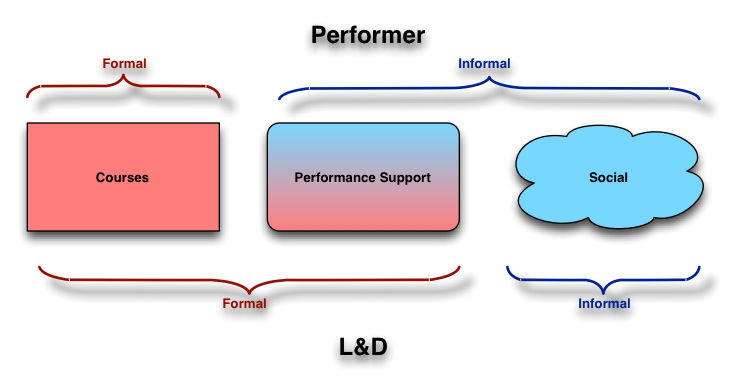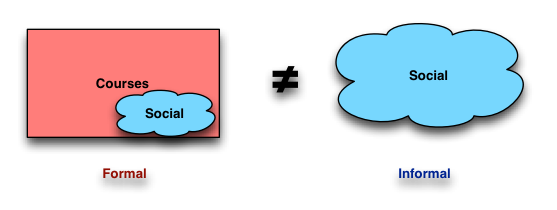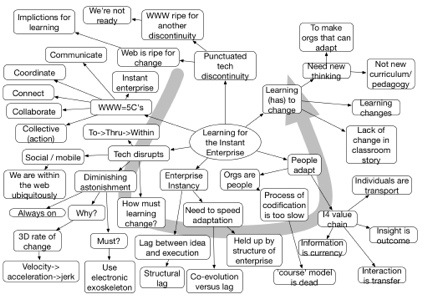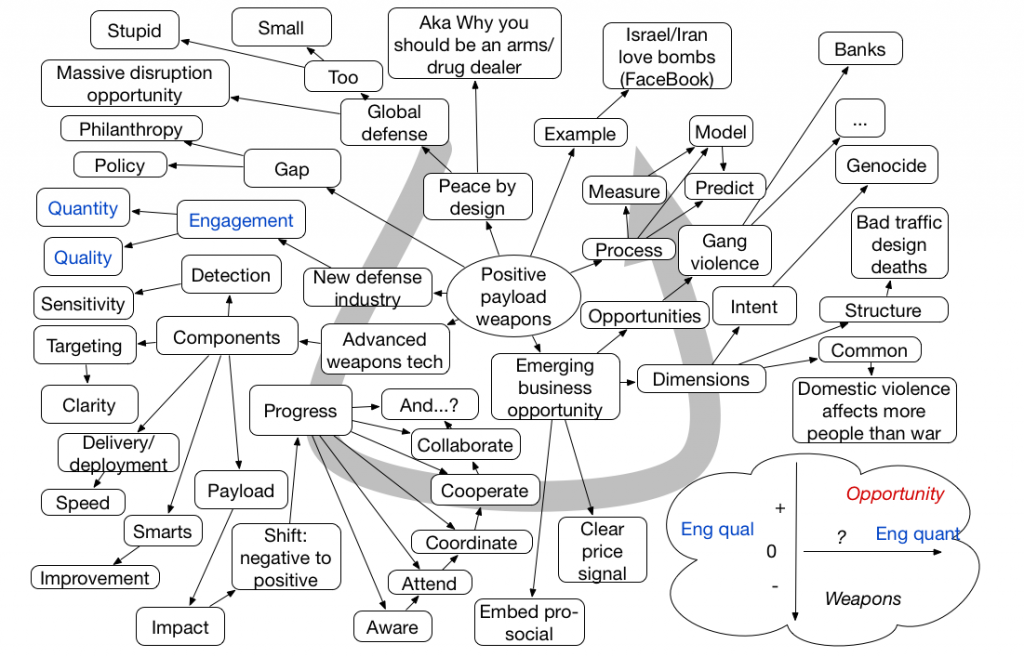Tony O’Driscoll kicked off the Innovations in eLearning Symposium with an entertaining and apt tour of the changes in business owing to information change, and the need to adapt. My take was that organizations have to become in a more organic relationship with their ecosystem by empowering their people to engage and act. His final message was that the learning community are the folks who have to figure this out and engage.
Taking the step
A while ago, I wrote an article in eLearnMag, stating that better design doesn’t take longer. In it, I suggested that while there would be an initial hiccup, eventually better design doesn’t take longer: the analysis process is different, but no less involved, the design process is deeper but results in less overall writing, and of course the development is largely the same. And I’m interested in exposing what I mean by the hiccup.
What surprised me is that I haven’t seen more movement. Of course, if you’re a one-person shop, the best you could probably do is attend a ‘Deeper ID’ workshop. But if you’re producing content on a reasonable scale, you should realize that there are several reasons you should be taking this on.
Most importantly, it’s for effectiveness. The learning I see coming out of not only training shops and custom content houses, but also internal units, is just not going to make a difference. If you’re providing knowledge and a knowledge test, I don’t care how well produced it is, it’s not going to make a difference. This is core to a unit’s mission, it seems to me.
 It’s also a case of “not if, but when” when someone is going to come in with an effective competing approach. If you can’t do better, you’re going to be irrelevant. If you’re producing for others, your market will be eaten. If you’re producing internally, your job will be outsourced.
It’s also a case of “not if, but when” when someone is going to come in with an effective competing approach. If you can’t do better, you’re going to be irrelevant. If you’re producing for others, your market will be eaten. If you’re producing internally, your job will be outsourced.
Overall, it’s about not just surviving, but thriving.
Yes, the nuances are subtle, and it’s still possible to sell well-produced but not well-designed material, but that can’t last. People are beginning to wake up to the business importance of effective investments in learning, and the emergence of alternate models (Khan Academy, MOOCs, the list goes on) is showing new ways that will have people debating approaches. It may take a while, but why not get the jump on it?
And it’s not about just running a workshop. I do those, and like to do them, but I never pretend that they’re going to make as big a difference as could be achieved. They can’t, because of the forgetting curve. What would make a big difference isn’t much more, however. It’s about reactivating that knowledge and reapplying.
What I envision (and excuse me if I make this personal, but hey, it’s what I do and have done successfully) is getting to know the design processes beforehand, and customizing the workshop to your workflow: your business, your processes of working with SMEs, your design process, your tools, and representative samples of existing work. Then we run a workshop where we use your examples. Working through the process, exploring the deeper concepts, putting them into practice, and reflecting to cement the learning. Probably a day. People have found this valuable in an of itself.
However, I want to take it just a step further. I’ve found that being sent samples of subsequent work and commenting on it in several joint sessions is what makes the real difference. This reactivates the knowledge, identifies the ongoing mistakes, and gives a chance to remediate them. This is what makes it stick, and leads to meaningful change. You have to manage this in a non-threatening way, but that’s doable.
There are more intrusive, higher-overhead ways, but I’m trying to strike a balance between high value and minimal intensiveness to make a pragmatic but successful change. I’d bet that 90% of the learning being developed could be improved by this approach (which means that 90% of the learning being developed really isn’t a worthwhile investment!). It seems so obvious, but I’m not seeing the interest in change. So, what am I missing?
Getting Pragmatic About Informal
In my post on reconciling informal and informal, I suggested that there are practical things L&D groups can do about informal learning. I’ve detected a fair bit of concern amongst L&D folks that this threatens their jobs, and I think that’s misplaced. Consequently, I want to get a wee bit more specific than what I said then:
- they can make courses about how to use social media better (not everyone knows how to communicate and collaborate well)
- share best practices
- work social media into formal learning to make it easier to facilitate the segue into the workplace
- provide performance support for social media
- be facilitating the use of social media
- unearth good practices in the organization and share them
- foster discussion
I also noted “And, yes, L&D interventions there will be formal in the sense that they‘re applying rigor, but they‘re facilitating emergent behaviors that they don‘t own“. And that’s an important point. It’s wrapping support around activities that aren’t content generated by the L&D group. Two things:
- the expertise for much doesn’t reside in the L&D group and it’s time to stop thinking that it all can pass through the L&D group (there’s too much, too fast, and the L&D group has to find ways to get more efficient)
- there is expertise in the L&D group (or should be) that’s more about process than product and can and should be put into practice.
So, the L&D group has to start facilitating the sharing of information between folks. How can they represent and share their understandings in ways the L&D group can facilitate, not own? How about ensuring the availability of tools like blogs, micro-blogs, wikis, discussion forums, media file creating/sharing, and profiles, and helping communities learn to use them? Here’s a way that L&D groups can partner with IT and add real value via a synergy that benefits the company.
That latter bit, helping them learn to use them is also important. Not everyone is naturally a good coach or mentor, yet these are valuable roles. It’s not just producing a course about it, but facilitating a community around these roles. There are a lot of myths about what makes brainstorming work, but just putting people in a room isn’t it. If you don’t know, find out and disseminate it! How about even just knowing how to work and play well with others, how to ask for help in ways that will actually get useful responses, supporting needs for blogging, etc.
There are a whole host of valuable activities that L&D groups can engage in besides developing content, and increasingly the resources are likely to be more valuable addressing the facilitation than the design and development. It’s going to be just too much (by the time it’s codified, it’s irrelevant). Yes, there’ll still be a role for fixed content (e.g. compliance), but hopefully more and more curricula and content will be crowd-sourced, which increases the likelihood of it’s relevance, timeliness, and accuracy.
Start supporting activity, not controlling it, and you will likely find it liberating, not threatening.
Help? Two questions on mobile for you
In the process of writing a chapter on mobile for an elearning book, the editor took my suggestion for structure and then improved upon it. I’d suggested that we have two additional sections: one on hints and tips, and the others on common mistakes. His suggestion was to crowd-source the answers. And I think it’s a good idea, so let me ask for you help, and ask you to respond via comments or to me personally:
- What are the hints and tips you’ve found valuable for mlearning?
- What are the mlearning mistakes you’ve seen or experienced that you’d recommend others avoid?
I welcome seeing what you come up with!
Design Readings
Another book on design crossed my radar when I was at a retreat and in the stack of one of the other guests was Julie Dirksen’s book Design for How People Learn and Susan Weinschenk’s 100 Things Every Designer Needs to Know About People. This book provides a nice complement to Julie’s, focusing on straight facts about how we process the world.
Dr. Weinschenk’s book systematically goes through categories of important design considerations:
- How People See
- How People Read
- How People Remember
- How People Think
- How People Focus Their Attention
- What Motivates People
- People Are Social Animals
- How People Feel
- People Make Mistakes
- How People Decide
Under each category are important points, described, buttressed by research, and boiled down into useful guidelines. This includes much of the research I talk about when I discuss deeper Instructional Design, and more. While it’s written for UI designers mostly, it’s extremely relevant to learning design as well. And it’s easy reading and reference, illustrated and to-the-point.
There are some really definitive books that people who design for people need to have read or have to hand. This fits into the latter category as does Dirksen’s book, while Don Norman’s books, e.g. Design of Everyday Things fit into the former. Must knows and must haves.
Flipping assessment
Inspired by Dave Cormier’s learning contract, and previous work at learner-defined syllabi and assessment, I had a thought about learner-created project evaluation rubrics. I’m sure this isn’t new, but I haven’t been tracking this space (so many interests, so little time), so it’s a new thought for me at any rate ;).
It occurred to me that, at least for somewhat advanced learners (middle school and beyond?), I’d like to start having the learners propose evaluation criteria for rubrics. Why? Because, in the course of investigating what should be important, they’re beginning to learn about what is important. Say, for instance, they’re designing a better services model for a not-for-profit (one of the really interesting ways to make problems interesting is to make them real, e.g. service learning). They should create the criteria for success of the project, and consequently the criteria for the evaluation of the project. I wouldn’t assume that they’re going to get it right initially, and provide scaffolding, but eventually more and more responsibility devolves to the learner.
This is part of good design; you should be developing your assessment criteria as part of the analysis phase, e.g. before you start specifying a solution. This helps learners get a better grasp on the design process as well as the learning process, and helps them internalize the need to have quality criteria in mind. We’ve got to get away from a vision where the answers are ‘out there’, because increasingly they’re not.
This also ties into the activity model I’ve been talking about, in that the rationale for the assessment is discussed explicitly, make the process of learning and thinking transparent and ‘out loud’. This develops both domain skills and meta-learning skills.
It is also another ‘flip’ of the classroom to accompany the other ways we’re rethinking education. Viva La Revolucion!
Making rationale explicit
In discussing the activity-based learning model the other day, I realized that there had to be another layer to it. Just as a reflection by the learner on the product they produce as the outcome of an activity should be developed, there’s another way in which reflection should come into play.
What I mean here is that there should be a reflection layer on top of the curricula and the content as well, this time by the instructor and administration. In fact, there may need to be several layers.
For one, the choice of activities should be made explicit in terms of why they’re chosen and how they instantiate the curricula goals. This includes the choice of products and guidance for reflection activities. This is for a wide audience, including fellow teachers, administrators, parents, and legislators. Whoever is creating the series of activities should be providing a design rationale for their choice of activities.
Second, the choice of content materials associated with the activities should have a rationale. Again, for fellow teachers, administrators, parents, and legislators. Again, a design rationale makes a plausible framework for dialog and improvement.
In both cases, however, they’re also for the learners. As I subsequently indicated, I gradually expect learners to take responsibility for setting their own activities, as part of the process of becoming self learners. Similarly, the choice of products, content materials, and reflections will become the learners to improve their meta-learning skills.
All together, this is creating a system that is focused on developing meaningful content and meta-learning skills that develops learners into productive members of the society we’re transitioning into.
(And as a meta-note, I can’t figure out how to graft this onto the original diagram, without over-crowding the diagram, moving somehow to 3D, or animating the elements, or… Help!)
Positive Payload Weapons Presentation Mindmap
The other evening I went off to hear an intriguing sounding presentation on Positive Payload Weapons by Margarita Quihuis (who really just introduced the session) and Mark Nelson. As I sometimes do, I mind mapped it.
I have to say it’s an intriguing framework, but it appeared that they’ve not yet really put it into practice. In short, as the diagram in the lower right suggests, weapons have evolved to do more damage at greater range (from knives one on one to atomic bombs across the world). What could we do to evolve doing more good at greater range? From personal kudos to, well, that’s the open question. They cited the Israel-Iran Love Bombs as an example, and the tactical response.
Oh, yeah, the drug part is the serotonin you get from doing positive things (or something like that).
Reconciling Formal and Informal
Recently, there’s been a lot of talk about informal learning, which ends up sounding like formal learning, and this can be confusing. So I’ve been trying to reconcile these two viewpoints, and this is how I’m seeing it.
There are really two viewpoints: that of the learning and development (L&D) professional, and that of the performer. Each of these sees the world differently, and we need to separate these out.
 Let’s get formal learning out of the way first. Performers know when they’re on deck for a course. They’re even willing to take courses when they know there’s a significant skill shift they need, or when they’re novices in a new area. If you’ve addressed the emotional side – motivation and anxiety – they can be eager participants. And L&D knows formal learning (all too well), they know how to design and develop courses (or think they do; there’s a lot of bad stuff being produced under the rubric ‘course’ that’s a waste of time and money, but that’s another topic).
Let’s get formal learning out of the way first. Performers know when they’re on deck for a course. They’re even willing to take courses when they know there’s a significant skill shift they need, or when they’re novices in a new area. If you’ve addressed the emotional side – motivation and anxiety – they can be eager participants. And L&D knows formal learning (all too well), they know how to design and develop courses (or think they do; there’s a lot of bad stuff being produced under the rubric ‘course’ that’s a waste of time and money, but that’s another topic).
Now, let’s move on to informal learning, as this is where, to me, we have a conflict.
The performer is focused on the tasks they need to perform. When they’re practitioners in the area, they’re much more likely to want the resources ‘to hand’: job aids, information, wizards, etc. This also includes search engines, portals, and more. Further, they’re likely to want people when that’s relevant: coaching, mentoring, answers that aren’t yet codified, finding new ideas and solutions. The latter, resources and people, are to them informal learning. They’re answers, not courses.
Now, from the perspective of the L&D group, job aids are formal learning. They’re designed, developed, and delivered. They’ve got the ‘secret sauce’ provided by folks who understand how we perceive information, work, learn, and more. So here we have a mismatch. Now, not all L&D groups take ownership of this area, but they could and should. (While I think portals should be too, it’s less likely that the L&D group has a role here, and that too should change.)
Then we move to the social side: communication, collaboration, and more. Here, L&D and the performer are largely in agreement, this is informal learning. However, there’s really another mismatch. L&D tends to think there’s little they can do here, and that’s a mistake. They can do several things: they can make courses about how to use social media better (not everyone knows how to communicate and collaborate well), share best practices, work social media into formal learning to make it easier to facilitate the segue into the workplace. They can also provide performance support for the social media, and be facilitating it’s use. They can unearth good practices in the organization and share them, foster discussion, etc; seed, feed, weed, and breed. (And, yes, L&D interventions there will be formal in the sense that they’re applying rigor, but they’re facilitating emergent behaviors that they don’t own.)
This latter, the use of social media in the organization for work should happen, as that’s where the continual innovation happens. As I say: optimal execution is only the cost of entry; continual innovation is the necessary competitive differentiator. Formal learning helps execution, and so does performance support, but innovation comes from social interaction. And L&D groups shouldn’t leave innovation to chance. They have a role to play.
 There’s one more confounding factor. Adding social into formal learning is worthwhile, but folks might get confused that doing so is also informal learning, and it’s not. Having requirements for personal reflections via a blog, discussions via forums, and collaborative assignments via wikis, and more, to facilitate learning are all good things, but certainly from the view of the performer it is not informal.
There’s one more confounding factor. Adding social into formal learning is worthwhile, but folks might get confused that doing so is also informal learning, and it’s not. Having requirements for personal reflections via a blog, discussions via forums, and collaborative assignments via wikis, and more, to facilitate learning are all good things, but certainly from the view of the performer it is not informal.
So, when you hear someone talking about informal learning and it sounds like formal learning, realize that they may be missing this final piece, the perspective of the performer. L&D can and should take on informal learning as well, but it’s not helpful if they think that just doing performance support and adding social into formal learning is all that needs to be considered as informal learning.
That’s the way I’m seeing the confusion emerge. Does it make sense to you?
Applying Expertise
I’m trying to get my mind around how the information we’re finding out about expertise matches to the types of problems people face. Clearly, you want to align your investments appropriately to situations you face. If you look across the literature on expertise, and the recent writing on how our brains work (c.f. Kahneman’s Thinking Fast and Slow), you see an emerging picture of expertise. When you combine this with the situations organizations are increasingly facing, you recognize that we need to get more granular about the types of problems we’re facing and the solutions we have on tap.
Starting with the types of problems, there are more than just the problems we know and the ones we don’t. When you look at the Cynefin model, which characterizes the types of problems we face, we see what types of expertise are helpful. Beyond work that should be automated, there are formulaic types of complicated problems that can be outsourced or accomplished by skilled or well-supported practitioners. Then there are the complex problems that require deeper expertise. Beyond that is the chaotic state where you have to try something to move it into one of the other states, and there are certainly reasons to believe that deep expertise .
So now we look at what’s known about our knowledge. We’ve known for a while that expertise is slowly accumulated, and becomes deeper in ways that are hard to unpack (hence why you need some detailed approaches to get at their understanding). What’s also becoming clear is that this ability to make expert judgements, once compiled away, is most effective in quick (not laborious) application, with a caveat. As Kahneman tells us, this expertise needs to be developed in a field that is “sufficiently regular to be predictableâ€, and in which the expert gets quick and decisive feedback on whether he did the right or the wrong thing. Otherwise, you need to do the hard yards, the slow thinking that’s effortful and systematic. Now, if it’s out of your area of expertise but a known problem, you have two choices: either take a well-known (and appropriate) but laborious approach, or hire the appropriate expertise. If it’s a relatively novel situation, either unique or new, you’ll need a different type of expertise.
We can infer that having a rich suite of models and frameworks helps in circumstances where the right solution isn’t obvious. The conclusion is clear: advanced experts may not immediately know the solution if the problem is reasonably complex (if so, you can get by with a practitioner), but their deeply developed intuition, based upon experience, and associated approaches to those types of problems will have a higher likelihood of finding a solution. Particularly if their expertise spans problem-solving in general, and specific expertise in at least some of the involved domains. Experience solving complex problems, and having a deep and broad conceptual background increases the likelihood of a systemic and comprehensive solution.
To think about it another way, this article makes a distinction between puzzles and mysteries. Puzzles have an answer, once you identify the information needed, collect it, and execute against it. This is the ‘Complicated’ part of the Cynefin situation. Mysteries are where you can’t know what will happen, and you have to experiment. This is the ‘Complex’ or ‘Chaotic’ parts of the model. You’re better off in the latter two if you’ve got good systems thinking, and a suite of useful models in your quiver.
So, when facing a problem, you have to characterize it: is this a puzzle where someone has an off-the-shelf solution “ah, we know that pain, and we solve it this way”, versus the mystery situation where it’s not clear how things will sort out, and you need a much richer conceptual background to address it. In the former case, you can find vendors or consultants with specific expertise. In the latter, the implication clearly is that you want someone who’s been thinking and doing this stuff as long as possible. You want someone who can guide some experiments.
The risk of trying to solve the complex problems with off-the-shelf solutions or DIY is that your answer is likely to be missing a significant component of the situation, and consequently the solution will be partial. You need the right type of expertise for the right type of problem.

